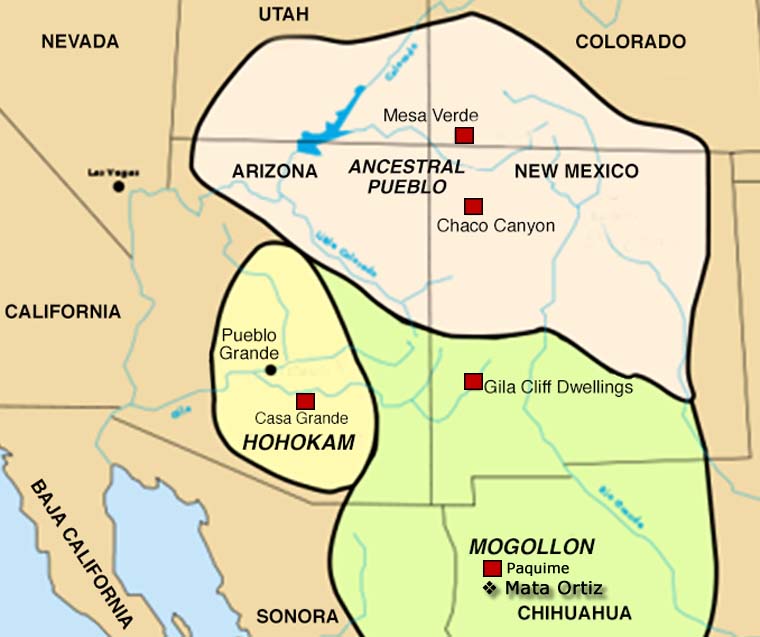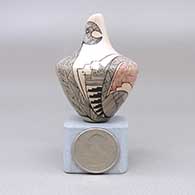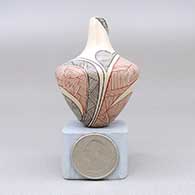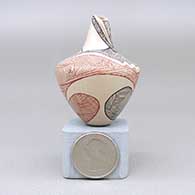
Carla Martinez
Mata Ortiz andCasas Grandes
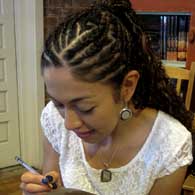
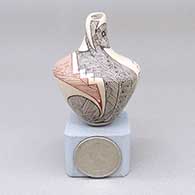
Married to Diego Valles, Carla Martinez works with a wide range of clays to make everything from miniature lidded pots to large and graceful traditional pieces. However, it's her miniatures that are most popular and have made her famous. In 2013 her miniatures won 1st and 2nd Place ribbons at the Arizona-Sonora Desert Museum's Women Potters of Mata Ortiz show. Since then she won 1st Place ribbons at the Mata Ortiz Concurso for her miniatures in 2016, 2017 and 2018.
Carla was teaching engineering courses in Nuevo Casas Grandes before moving to Mata Ortiz and learning to make pots. She likes to fill out the major part of the design elements on a pot, then paint on a spider web pattern that fills the gaps in the main design elements (this is part of what makes the Porvenir style different from the Quezada style in Mata Ortiz pots).
She works with Diego often these days and she says that has stretched her pottery and design horizons in new directions. The two travel the world together as Diego is internationally known and often asked to give pottery-making demonstrations and lead workshops.
100 West San Francisco Street, Santa Fe, New Mexico 87501
(505) 986-1234 - www.andreafisherpottery.com - All Rights Reserved

Mata Ortiz and Casas Grandes

The macaw pens at Paquimé
Casas Grandes is both a municipality and an archaeological district in northern Chihuahua State, Mexico. The archaeological district includes the pre-historic ruins of Paquimé, a city that began to build around 1130 AD and was abandoned about 1450 AD. Archaeologists are uncertain as to whether Paquimé was settled by migrants from the Mogollon/Mimbres settlements to the north or by Anasazi elite from the Four Corners region in the United States or by others. Over the years Paquimé was built into a massive complex with structures up to six and seven stories high with multiple Great Houses in the surrounding countryside. Today, the site is a UNESCO World Heritage Site.
Mata Ortiz is a small settlement inside the bounds of the Casas Grandes municipality very near the site of Paquimé. The fortunes of the town have gone up and down over the years with a real economic slump happening after the local railroad repair yard was relocated to Nuevo Casas Grandes in the early 1960's. The town was in steady decline until Juan Quezada, a poor farmer who gathered firewood in the area of the archaeological site, was inspired by fragments of ancient Paquimé pottery and even older fragments of Mimbres forms with bold black-on-white designs littering the ground to learn more.
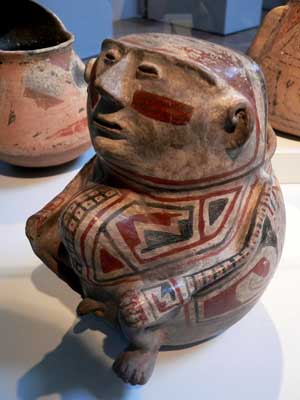
Ramos Polychrome effigy pot from Paquimé
Quezada was successful in his quest to learn to recreate the ancient process using slightly more modern techniques (although no one in the present tradition uses a potter's wheel). He learned to use sand and other coarse materials for temper. He discovered that dried cow dung made an excellent and inexpensive firing fuel. Instead of using gourds for smoothing he substituted broken hacksaw blades. Instead of using yucca fiber brushes for painting he learned to make brushes with human hair. He persevered in his efforts and by 1971 had produced a kind of polychrome pottery. Since then, most pottery-making in the area has used innovations in the design and decoration of the pots but the materials and the basic crafting of the process have remained the same.
By the mid-1970s, Quezada had attracted a significant number of traders and his work was becoming a commercial success. That is when he began teaching his techniques to his immediate family. They in turn taught other family members, friends and the younger generations. Both women and men were included from the beginning.
Originally called Casas Grandes pottery in the early years of its production, the potters of this tiny village have made such an impact on the pottery communities, including many awards and special recognition from the Presidents of Mexico, that Mata Ortiz pottery is now becoming known around the world.
Today, pottery production has changed the village in many ways as there is now electricity, plumbing, vehicles and more for the residents. Virtually everyone in the small town (2010 population: 1,182) makes their living by working in some part of the pottery-making process, from potters to clay-gatherers to firewood collectors to traders.
Mata Ortiz pottery incorporates elements of contemporary and prehistoric design and decoration, and each potter or pottery family produces their own distinctive, individualized ware. Young potters from surrounding areas have been attracted to the Mata Ortiz revival and new potting families have developed while the art movement continues to expand. Without the restraints of traditional religious practices or gender constraints, a vibrant flow of new ideas has enabled the pottery of Mata Ortiz to avoid the derivative repetition common to virtually all folk art movements. This blend of economic need, gender equality, cultural expression and artistic freedom has produced a unique artistic movement in today's community.
Lower photo is courtesy of David Monniaux, Creative Commons Attribution-Share Alike 3.0 Unported License
100 West San Francisco Street, Santa Fe, New Mexico 87501
(505) 986-1234 - www.andreafisherpottery.com - All Rights Reserved

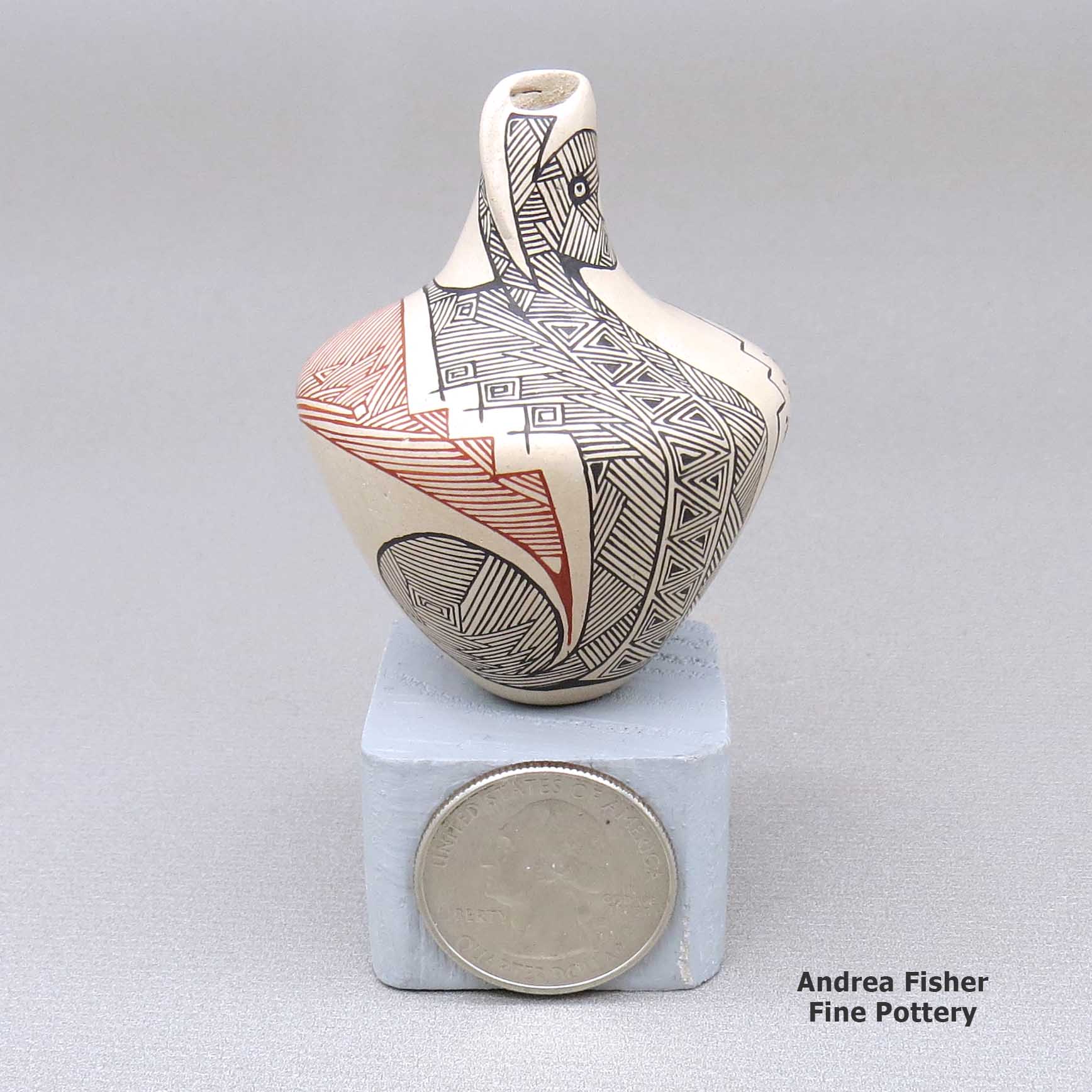
Carla Martinez, Mata_Ortiz_and_Casas_Grandes, Miniaturepolychromejarwithanorganicneckandopeningandageometricdesign
Mata Ortiz and Casas Grandes
$ 825
zzcg3d253m3
Miniature polychrome jar with an organic neck and opening and a geometric design
1.5 in L by 1.5 in W by 1.25 in H Stand shown for scale only
Condition: Excellent
Signature: Carla Martinez
Date Created: 2023
100 West San Francisco Street, Santa Fe, New Mexico 87501
(505) 986-1234 - www.andreafisherpottery.com - All Rights Reserved

Miniatures
Most people think that miniature pottery is something new in the world of Native American pottery. In reality, archaeologists have found miniature pottery in the remains of ancient ruins in Chaco Canyon, Mesa Verde, across eastern Arizona, southern New Mexico and south to the Paquimé and Casas Grandes region in northern Mexico. Archaeologists working in the eastern US have found miniature pottery spread across Early Woodland Culture sites, too, dated up to 1700 years ago.
We have no idea as to why the ancients created miniature pottery but there's lots of speculation. Perhaps it was made as toys for children. Perhaps it was made by children learning to make pottery, and as their expertise grew, the size of their pieces grew, too. Perhaps it was made and placed in a firing pit as a good luck charm, hoping that other pots being fired in the pit would survive the firing process and not crack or break. Perhaps it was made for some ceremonial purpose we have no possibility of knowing. We do know that in North America, almost every pottery-making group of ancients made miniature pottery. They decorated it, too, just like the full size pottery the women of the time were making.
As the rebirth of traditionally made Native American pottery has unfolded over the last century, research into the ancient forms, styles and designs has also brought the miniature back into focus. There are more than a few potters these days making tiny gems again, similar to and, at the same time, more refined than the products of the potters of prehistory. And while some are still being made by children learning as they grow up, many more are being made by established adult potters. Some have made their entire careers around the making of miniatures while others sometimes make a few miniatures to complement the full range of forms and styles of full size pieces they make.
100 West San Francisco Street, Santa Fe, New Mexico 87501
(505) 986-1234 - www.andreafisherpottery.com - All Rights Reserved

Genovevo Sandoval Family Tree
Genovevo Sandoval lived from 1864 to 1950. His first wife was Paula Gutierrez and she lived from 1885 to 1925. After Paula passed on, Genovevo married Josefa Trevizo (1908-1973). Many potters from the Mata Ortiz area are descended from Genovevo and his two wives.
Disclaimer: This "family tree" is a best effort on our part to determine who the potters are in this family and arrange them in a generational order. The general information available is questionable so we have tried to show each of these diagrams to living members of each family to get their input and approval, too. This diagram is subject to change should we get better info.
-
Genovevo Sandoval (1864-1950) & Paula Gutierrez (1885-1925)
- Marco Sandoval & Jesusita Rodriguez
- Eduviges Vicki Rodriguez & Salbador Ortiz (d. 1997)
- Paty Ortiz & Cruz Santillan
- Eduviges Vicki Rodriguez & Salbador Ortiz (d. 1997)
- Angel Sandoval & Maria
- Socorro Sandoval & José Silveira
- Lila Silveira & Carlos Carillo
- Saul Silveira & Sulma Orozco
- Yadira Silveira & Roberto Olivas
- Trinidad Trini Silveira
- Alondra Silveira
- Gustavo Silveira
- Socorro Sandoval & José Silveira
- Julia Sandoval & Francisco Valles
- Diego Valles Sr. & Angela Trevizo
- Diego Valles Jr. & Carla Martinez
- Armando Valles & Nayeli Perez
- Diego Valles Sr. & Angela Trevizo
-
Genovevo Sandoval (1864-1950) & Josefa Trevizo (1908-1973)
- Reyes Sandoval
- Monserrat Sandoval & Rojelio Silveira
- Julio Cesar Silveira
- Joel Silveira
- Rafael Silveira
- Israel Silveira
- Dolores Lola Sandoval & ? Carrillo
- Carlos Carrillo & Lila Silveira
- Monserrat Sandoval & Rojelio Silveira
- Antonio Sandoval & Refujio Mendoza
- Celia Sandoval & Felix Ortiz
- Macario Ortiz
- Raquel Ortiz & Chester Ortiz
- Sofia Sandoval & Roberto Beto Tena
- Gerardo Tena & Norma Hernandez de Tena
- Gerardo Tena Jr.
- Mariela Tena
- Melissa Tena
- Adolfo Fito Tena
- Gerardo Tena & Norma Hernandez de Tena
- Maria Jesus Sandoval & Aureliano Ortiz
- David Ortiz & Anastasia Mancino
- Luiz Ortiz & Maricela Olivas
- Jesus Maria Sandoval & Juan Mora Sr.
- Olivia Mora Sandoval & Armando Rodriguez
- Abraham Rodriguez
- Luis Armando Rodriguez
- Juan Mora Sandoval
- Julio Mora (1971- ) & Alma Soto (1974- )
- Lucia Mora
- Anastacio Mora
- Antonia Mora
- Olivia Mora Sandoval & Armando Rodriguez
- Genoveva Sandoval & Nicolas Silveira
- Armando Silveira & Tomasa Mora
- Arminda Silveira
- Octavio Tavo Silveira & Myrna Hernandez
- Jesus Octavio Silveira
- Octavio Silveira
- Silvia Silveira & Tomas Ozuna
- Lazaro Ozuna
- Veronica Silveira & Sabino Villalba
- Tomasa Silveira
- Eusebio Chevo Sandoval & Esperanza Tena
- Cesar Sandoval
- Dora Sandoval
- Ismael Sandoval
- Celia Sandoval & Felix Ortiz
(505) 986-1234 - www.andreafisherpottery.com - All Rights Reserved
